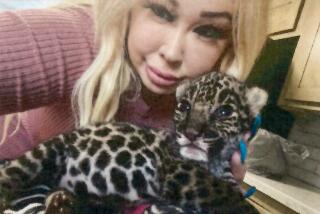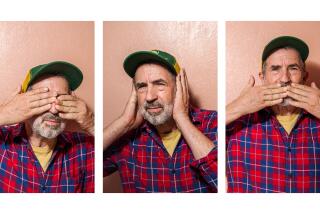‘The Bird Stops Here,’ Rescuer Says : His Hobby Hatched a Hospital for Raptors and Other Feathered Friends
- Share via
MILLINGTON N. J. — It is hard to say just when a man decides to turn his yard into a repair shop for wrecked birds.
For Leonard Soucy, it probably happened 20 years ago, when someone left a red-tail hawk with a broken wing in a cardboard box on his front stoop.
It was a challenge Soucy couldn’t resist. He still can’t.
That is why his home is an intensive-care facility full of cages--some the size of boxcars--where he endeavors to restore to the wild sick and injured owls, hawks, eagles, falcons, songbirds--and the occasional lame duck.
In earthy terms appropriate to a pirate’s parrot, Soucy tells how the birds have taken over his home, his bank account, his job and even his wife, Diane.
“Birds have eaten me up. They’ve consumed my life.”
These are the birds who came to dinner, as it were. For their convalescence, Soucy buys 10,000 crickets a week from a Tennessee breeder, millions of grubworms from California, grasshoppers galore from Georgia and 150,000 rodents a year.
“I have 10,000 mealworms here right now, and they’re just snacks!” he said. “This cost $100,000 last year. If the food wasn’t donated, it would have cost $250,000. Just one rat costs $2.50. A mouse is $1.09 . . . but I have to do it. No one else is going to.”
Owls, Eagles, Hawks
Soucy may have as many as 500 recovering birds at a time in his 100,000 cubic feet of cages. There’s a barred owl on the mend from an entanglement with a kite string, a golden eagle with a broken wing, and hawks shot by what Soucy calls, with unprintable modifiers, “slobs.” Orphaned birds are raised from infancy. An oriole must winter over because it did not recover until after the last flight south.
Soucy still tries to sandwich his work as a self-employed tool-and-die pattern maker around a hobby that was once a Sopwith Camel and is now a B-52. This sometimes requires him to go to his paying job at 2 a.m. There are emergency calls at all hours.
“A bird gets hit, falls out of the nest. It doesn’t belong to the police. Not the dog warden. Doesn’t belong to anybody. So they say ‘Call Soucy.’ ” A screech owl flies down a chimney and catches fire. Call Soucy. A goshawk crashes through a picture window and lands, dazed, on a coffee table. Call Soucy.
“There’s nobody else to pass them to. The bird stops here.”
Year for the Birds
Last year, Soucy’s busiest ever, 1,485 wild birds ended up on his doorstep. They included 240 raptors, the carnivores that are his specialty. About half the birds recovered and were returned to the wild. Repairs are not cheap.
“To do an intramedullary fusion of a bird’s wing bone with a pin can cost $400 for the operation. Post-op care can approach $1,000.”
Fortunately, Soucy has two understanding veterinarians nearby--Dr. Andrew Major in Plainfield and Dr. Ken Jacobsen in Basking Ridge--who donate their surgical services.
“We can keep a bird alive 90% of the time, but can we restore it 100%? The bird won’t make it in the wild if it’s only 75%, so we keep about 100 for educational lectures at schools and such, and euthanize the rest.”
Soucy’s preoccupation with raptors is evolutionary. He was born in Cedar Grove, N. J., 57 years ago when it had some open land and nothing like the 40,000 people who pack it today. He learned about nature from an uncle who was a hunter--a species with whom Soucy has no quarrel, despite the many gunshot-maimed birds he’s treated.
“No competent, moral hunter will shoot hawks and owls. The (bleeping) slobs do.”
His interest was piqued years ago when he read an article on hawks in Audubon magazine. He and Diane went out to Hawk Mountain in eastern Pennsylvania to see the migration of autumn, when thousands of raptors may fly by in a day, riding the thermals south.
“I couldn’t imagine 1,000 hawks in the whole world, much less overhead.”
Gunners used to shoot hundreds of birds in a day at Hawk Mountain, just for target practice. This was ended in 1934, when Rosalie Edge, a wealthy New Yorker, bought the mountain and made it a refuge for the birds and bird watchers. Cape May, an even bigger migration junction at the southern tip of New Jersey, was also a hunting ground, but this stopped when the federal government outlawed shooting of raptors in 1972.
By then, Soucy and Diane had been in the bird-repair business 4 years. They had rehabilitated that first red-tail and released it. One thing led to another. They bought a house in the country next to the Great Swamp Wildlife Refuge here. It all started as a back yard hobby, a way of righting some of the wrongs committed by the most deadly predator of them all, man.
“The stupidity of man not doing better gradually enraged me. All things on Earth are valuable to us because they help stabilize the darn thing. I was raised to think man owned the world. We’ve got to get out of this idea, because we’re a part of it. It’s all our world. We’ve got to take care of Momma Earth.”
He had no illusions about it being easy.
“Historically, this country has a love-hate relationship with raptors. We put the bald eagle on our national seal, but there used to be a bounty on them. People don’t care if a robin kills a worm, but it’s what’s being killed that matters. A fox that kills a chicken is a bad fox. If it kills a snake, it’s a good fox. To hunters, a hawk that killed a rabbit was a bad thing, so they killed the hawk, and then the rabbit. Farmers thought raptors were vermin, but very, very, very few hawks will kill chickens . . . but that’s a hard sell.”
Soucy accepts raptors for what they are, meat-eaters in nature’s scheme, just like the folks at Burger King.
“Raptors are truly remarkable animals. An owl can see a lighted match a half-mile away. A hawk 2 miles up can see a rabbit and know it’s a rabbit. They probably have the best eyesight in the whole world.” He admires the birds for trying to adapt to a world not of nature’s making.
As Soucy’s reputation grew, so did the number of cages out back. He is a realist, however. He will not turn away a tearful youngster who shows up with a young phoebe that has fallen out of the nest, but his eye cannot be on every sparrow.
“Obviously,” he said, “there are limits.”
He and Diane learned as they went along, designing cages and treating their patients so as not to make permanent welfare cases of them. There have been triumphs.
“In 1982, which happened to be the national year of the bald eagle, one of them fell out of the sky. It ended up here. I took it to Bill Hobby, a local vet, and he got an IV into the bird. He found it had too much mercury in its blood. Six weeks later, we flew him down to Chesapeake Bay in a donated Learjet with an NBC-TV crew, and returned a healthy eagle to the sky.”
In time, the big birds began running into big money. “It costs $175 to air-freight a recovered osprey down to Florida after migrating season. I’ve shipped ferruginous hawks to Arizona. When it looked like Diane was going down in a heap and I couldn’t afford it anymore, a friend said we should incorporate.”
They are now The Raptor Trust, eligible for tax-exempt donations. A local lumber company donates wood for cages. AT&T;, which has huge office complexes in the area, gave $7,000 for a new cage. In summer, the Soucys have five full-time staffers and 25 volunteers. Their hobby has become one of the 10 biggest-bird recovery operations in the nation.
“We took a 5-day vacation this year, the first in 16 years. I hired Jean Stamy, an ex-teacher, to show school groups around. I told her she’d work harder and be paid less if she came to me. I kept my promise.
“The reality is, how big can we get? We don’t charge for our services--to whom do you send a bill? So we have to beg. That’s what I’ve become, a beggar.”
Soucy has raised $185,000 to buy the property next door for more space and an educational center.
“I like to think we’re setting an example. In the last 20 years, Americans have gone back to being more intolerant of nature, gone back to their computers and Porsches. If they had more sympathy for the planet that sustains us, maybe they wouldn’t puke on their world so much.
“I figure I’ve put 100,000 hours into all this, and I’ve never taken a dime out,” said Soucy, strolling among the cages under the penetrating stares of his patients.
More to Read
Sign up for The Wild
We’ll help you find the best places to hike, bike and run, as well as the perfect silent spots for meditation and yoga.
You may occasionally receive promotional content from the Los Angeles Times.






